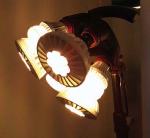Integrated LED Luminaires and Ecodesign of LED
Christian Schraft of Osram AG characterized the traditional lighting market as being split into two distinct segments: lamps and fixtures. The former was global, standardized, and based on the demand created by replacement. There were a small number of leading suppliers, in what William Mackie of Berenberg Bank referred to as a ※comfortable oligopoly.§ The traditional fixtures market could be characterized, said Schraft, as application-specific and regional, with small-batch production. The introduction of LEDs created a ※lifetime light source§ that will ultimately eliminate the replacement business, said Schraft. Integrated LED luminaires are another unprecedented feature of the evolving lighting industry.
| Drivers |
Characteristics |
Growth |
|
Demographic change |
More people, more elderly |
|
|
Electrification |
More grids |
Volume based |
|
Emerging market shift |
More income |
|
|
Energy efficiency |
More-efficient lamps |
|
|
De-carbonization |
More bans/restrictions |
Value based |
|
Digitalization |
More intelligence |
|
|
Emotionalization of light |
Light used for special events and setting the mood |
Quality of life |
Table l. A variety of driving forces are shaping the future of the global lighting market. (Source: Christian Schraft, Osram AG)
Changes in the market also impact how lighting companies operate. Previously, companies supplied either lamps or fixtures (with Philips as a notable exception) but now ※the boundaries are blurred,§ said Schraft. Osram already operates at many different points on the value chain, ranging from its LED-making subsidiary Osram Opto Semiconductors to recently-acquired fixture and system suppliers Siteco and Traxon. Overall, Osram AG generated about 25% of its revenue in fiscal 2011 from SSL, said Schraft.
Of course, another impact of the inroads made by SSL is the emergence of smaller companies specializing in SSL technology. Berenberg*s Mackie commented that, while industry leaders are having to ※manage legacy and build bridges to the future,§ at the same time ※fragmentation and technology creates opportunities for new entrants.§
Schraft characterized the changes in the lighting industry as involving a transition to higher-value LED-based products and applications, and a transformation to intelligent networked solutions and value-added services. The drivers of change are summarized in Table 1.
Schraft contrasted the replacement of older lighting technologies with the way in which the TV industry has eliminated CRTs, and digital cameras have effectively eliminated film. However, lighting is different, said Schraft: although the market value of traditional (non-SSL) lighting peaked in 2011 it will still account for a third of the market in 2020. ※The installed base will have a long life, or &golden tail*,§ he said, and there will be coexistence of different technologies for many years to come.
Schraft also discussed different regional preferences. ※Warm-light countries§ typically prefer 3300K or below, and light quality is a key purchasing reason. These tend to be more-developed countries in North America and Europe that have a higher purchasing power. Conversely, many less-developed countries have a ※cold-light§ preference for light above 5000K, and low cost and energy saving are the primary purchasing reasons.
Ecodesign regulations and labeling
Jan Denneman, chairman of the Global Lighting Association (GLA), made the point that companies alone cannot set standards or influence regulations. This is where organizations such as the GLA and the European Lamp Companies Federation (ELC) come in. One of the people that the ELC might seek to influence with regard to European regulations is Andr芍s T車th of the Energy Efficiency unit of the Directorate-General (DG) for Energy at the European Commission (EC). At SIL Europe, T車th provided an update on the new Ecodesign and Energy Labelling regulations that should come into effect in September 2013. These and other European regulations, projects and funding schemes were discussed a recent LEDs Magazine article.
The Energy Labeling regulation (874/2012) has been adopted by the EC, and in the week following SIL Europe it was published in the OJ (Official Journal of the European Union). It will become directly applicable in all EU Member States from September 1, 2013. The same start date is planned for the new Ecodesign regulation, but this is currently within a scrutiny period (see Table 2).
The revised version of the energy label for lamps has new A+ and A++ classes, which are specifically designed to allow LEDs to demonstrate their capabilities. The label (or package) must also display a value for energy consumption in units of kWh per 1000 hours. The class is determined by the value of the energy-efficiency index (EEI), with different values applying to non-directional and directional lamps. The EEI is the ratio of the power corrected for any control-gear losses compared with the reference power. The latter is obtained from the useful luminous flux; this is the total flux for non-directional lamps, or the flux in a 90∼ or 120∼ cone for directional lamps.
Luminaires are also included in the new regulation, but there is no separate labeling requirement for LED modules that are integrated into luminaires. Replaceable modules will require a label.
Table 2. Update on two forthcoming EU regulations related to lamps and luminaires. Source: Andr芍s T車th, European Commission. *OJ = Official Journal of the European Union.
|

 English
English  Chinese
Chinese 





 English
English  Chinese
Chinese 



